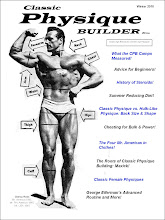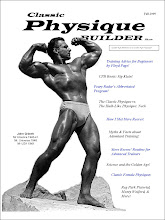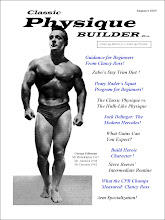 (Photo Above: CPB Champ Leo Robert - Mr. Canada 1951, Mr. Universe - Pro 1955)
(Photo Above: CPB Champ Leo Robert - Mr. Canada 1951, Mr. Universe - Pro 1955)One of our CPB Readers asked how the pre-roid Golden Age champs achieved their definition without doing all the cardio that is popular today. This is an important question because the time will come, in building a classic physique, when you will want to improve your definition. So it is important to understand the principles and practices that they used.
First, we should re-emphasize that classic physique definition of the pre-roid Golden Age was different than the "ripped, shredded, cadaver-like" look of today. The ideal of that age (the 1940s and 50s) was to have a classic physique that "radiated with vitality and the glow of health." For this look, the muscles had to be defined, yet there had to be a higher level of bodyfat (compared to modern bodybuilders) in order to provide the skin with that radiant look of vitality and health. So they (classic physique builders and judges) were not impressed by straited gluts and seeing every subcutaneous vein. The definition they admired still recalled the muscularity seen in the ancient classical Greek sculptures of the gods and heroes.
The following list is an incomplete list of principles and practices that the pre-roid Golden Age champs used in order to achieve their classic definition. These principles and practices would have been used differently by each individual depending on their circumstances (e.g., whether they "bulked" up and needed to "trim down" or whether they stayed in shape and simply wanted to improve their muscularity a bit). So please don't think that they necessarily used all these principles at the same time. Feel free to discuss these principles and practices in our comments section. It is the comments of the CPB Readers that really enrich CPB Blog!
Here is the partial list:
1. Cut calories and lower carbs (especially starchy foods and any foods considered fattening)
2. Use a very low carb diet (Vince Gironda's approach)
3. Use a higher rep range on exercises (e.g., 12-15 reps per set)
4. Cut down the rest time between sets and exercises
5. Increase the number of exercises and sets per body part
6. Some champs did add running to their exercise regimen (this was not a universal practice)
7. Switch from a 3 day per week full body schedule to a 4, 5, or 6 day split a few weeks before a contest
8. Train with chest expanders (steel cable exercisers)
9. Take a vitamin-mineral supplement
10. Reduce salt intake
11. Don't eat between meals
12. Avoid excessive rest and do not take naps
13. Be more active in general
Again, this is a partial list (gathered from the muscle mags and courses of the pre-roid Golden Age). But it gives you a good idea. They didn't need high tech "fat burning/thermogenic" supplements or intense, daily "cardio" sessions, roids, or even extreme diets (except in the case of Vince and his very low carb approach). You will notice that their principles and practices also didn't cost a lot of money! Theirs was a simple and effective approach and left them with physiques that looked great and healthy! What more could any classic physique builder want!
- CPB
P.S. For a free 1 year subscription to Classic Physique Builder (CPBzine) - a pdf "zine" (do-it-yourself magazine) patterned after the muscles mags of the pre-roid Golden Age of Bodybuilding (the 1940s and 50s) - just email your name, the name of your city (not your actual address), state/province, and country to cpbzine@gmail.com. That's it! Any info you send us is strictly confidential. We don't share info with anyone, so you won't get on any unwanted lists or receive any unwanted, automated email (even from us!).












